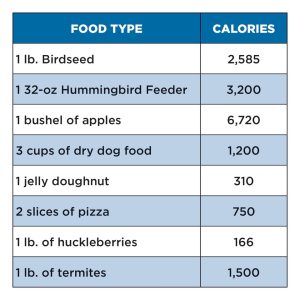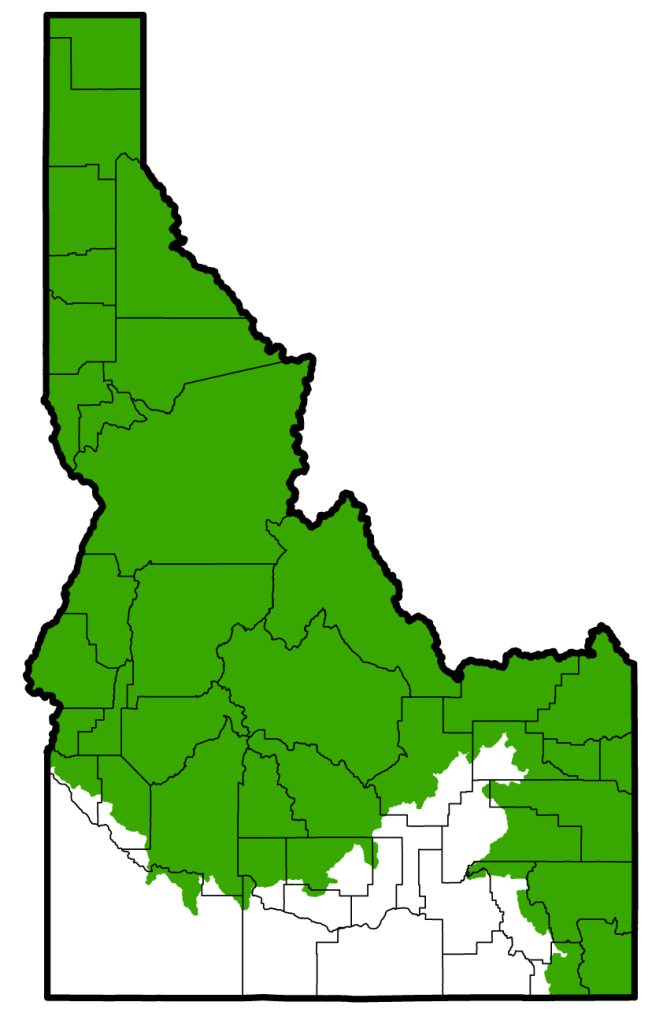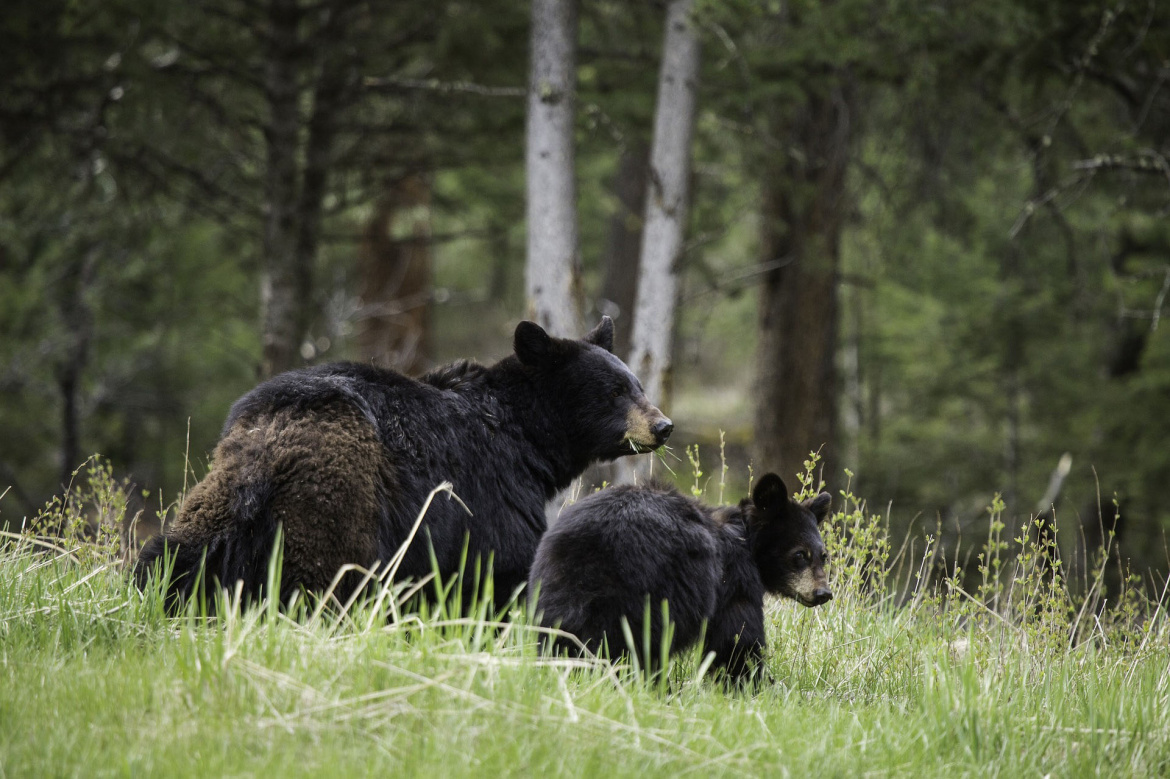It is the responsibility of people living in black bear habitat to help prevent conflicts. The Wood River Valley Wildlife Smart Communities Coalition does not believe there is such a thing as a “problem bear.” When a bear gets in to garbage, birdfeeders, pet food, or in to a house, the problem was never the bear (who is simply going after an easy meal). The problem is unsecured food items, or attractants. Luckily, a few changes in our behavior can remove these attractants and keep both people and bears safe. As a Wood River Valley resident, you play a vital role in ensuring that black bears stay wild. Without your help, bears that become conditioned to humans (oftentimes as a direct result of human-provided food) will be euthanized. Once food-conditioned, a bear cannot be rehabilitated and released back in to the wild (see research links). As the old adage goes, “A fed bear is a dead bear.”
Contrary to popular belief, more than 90 percent of most black bear diets consist of vegetation: berries, nuts and plants. A bear’s keen nose can smell foods up to five miles away! Although towns have hazards such as dogs, cars, and people, they also have the benefits of calories from unsecured garbage. The table below compares the calorie contents of some natural and human sourced black bear foods:

When two slices of pizza from a dumpster provides more calories than an hour spent raking huckleberry bushes, the benefits of town can quickly outweigh the risks. In addition to great noses, bears have great memories, and will revisit a neighbor home many times once they’ve found food there.
Bear safety at home
Residents of the Wood River Valley can take the following steps to keep themselves and bears safe:
- Secure all residential garbage in a locked garage or shed and put out the morning of trash pickup (not the night before). The local trash disposal company trucks don’t even begin their day of picking up residential garbage until 7:00 a.m.
- Do not feed birds during the months when bears are active
- Do not leave pet food outside.
- If you have fruit trees or berry bushes, harvest fruit as it becomes ripe. Pick up and dispose of, or compost any fruit that falls on the ground.
- Do not leave windows or screen doors open if you are not home.
Bear safety when recreating in black bear habitat:
- Keep a clean camp. Contain all left-over food scraps and coffee grounds in a trash bag.
- Do not keep food or odorous items (i.e. pet food, soap, bug spray, lotion, toothpaste, chewing gum) in your tent! Familiarize yourself with the proper way to hang food before you go (link to hanging food or picture).
- If you will be camping where trees are limited, you should carry a portable, bear-resistant canister (see product list below) or odor-proof barrier bags.
- Carry bear spray with you and understand how to effectively use bear spray.
- Do not recreate with earbuds in. Impeding your ability to hear your surroundings is never a good idea when you are on the trail.
- Make noise as you travel, particularly if you are coming up to a corner in the trail, the brush around you is thick, or you are close to a stream. All of these can limit a bear’s ability to detect you. You do not want to sneak up on a bear, as a startled bear can quickly become an aggressive bear.
- Keep your dogs on a leash. Several instances of dogs running ahead of their owners and startling a bear, only to turn and lead that bear back to their owner have been reported. See our page “Dogs and Wildlife”
Sources for bear-resistant equipment
http://igbconline.org/certified-products-list/
https://www.bearsmart.com/play/securing-food-garbage/
https://www.bearsmart.com/play/bear-deterrents/bear-pepper-spray/
What to do if you encounter a black bear:
Most black bears prefer to avoid humans, which means encounters are fairly uncommon, however, if you do encounter a bear there are some actions you should take to minimize the chance of the situation escalating to an attack.
- Assess the situation – does the bear in front of you appear to have cubs? Is there a carcass or other food source close by?
- If the bear is seen at a large distance, do not approach it, and give the bear as much room as possible. Turn around and go back the way you came if you can, or take a detour, even if it means getting far off the trail.
- If you encounter a bear at close range on the trail, speak in a calm, firm tone. Back away slowly – never turn and run. Keep your eyes on the bear.
- If a bear approaches you, evaluate its behavior. If it is moving towards you slowly, without focusing much attention on you, it likely just wants to go about its business. Speak firmly to make sure the bear knows you are there. Get out of its way if you can (without running or turning your back). If there bear is focused on and follows you, stand your ground and prepare to use your bear spray.
- If you are at your campsite, you can try to encourage it to leave. Make sure the bear has an escape route first! Never antagonize a cornered bear. Make yourself look as big as possible and use what you can to make loud noises (a whistle, banging a pot, speaking loudly). Make sure you have a can of bear spray on you in this situation just in case the bear approaches you.
- If you are attacked by a black bear do not play dead. Deploy your bear spray if possible and fight back, focusing on the face, eyes, and nose. Fight any bear that attacks you in your tent.
Black Bears in Idaho
Black bears (Ursus americanus) are found throughout both the foothills and forests of Idaho. It is estimated that between 20,000 and 30,000 black bears roam these wild lands. Despite the name, some subspecies of black bears can be brown or even blond in coloration.
Black bears are omnivores, meaning they eat and survive on both plant and animal matter. Their diets varying greatly depending on season and location including roots, berries, meat, fish, insects, larvae, grass, and other succulent plants. They can kill adult deer and other hoofed wildlife but more commonly are only able to kill deer, elk, moose, and other hoofed animals when the prey those species are very young.
Black bear weight tends to vary according to age, sex, health and season of the year. Seasonal variation in weight can be very pronounced, for instance, in autumn, their pre-den weight tends to be 30 percent higher than in spring, when they emerge from their dens. Adult males in Idaho rarely weigh over 400 pounds, and typically range in weight from 150 – 250 pounds and adult females typically range in weight from 100 – 150 pounds.
Idaho black bear researcher, Dr. John Beecham in his book Shadow in the Forest found that black bears in Idaho are long-lived, mature late, and have low reproductive rates. Idaho black bear sows (females) usually produce their first litter at the age of five years. The breeding period usually occurs in mid-May through early August. The fertilized eggs undergo delayed implantation by not beginning to grow until November/December. The gestation period is approximately 220 days but active embryo growth only lasts 40-70 days. Litters are usually born in late January to early February, with a typical litter of two or three cubs. At birth cubs weigh less than a pound and measure about 8 inches length. They typically open their eyes after 28–40 days and begin walking after five weeks. Black bear cubs are dependent on their mother’s milk for about 5 months and will become independent from the sow at 16–18 months. Black bears have been documented in Idaho up to age 20, but that would not be considered typical.
Bears spend approximately one-third of the year in their den, sleeping through winter. To prepare for this, they spend most of their time during summer and fall fattening up by consuming as many calories as possible.
Black bear distribution in Idaho

